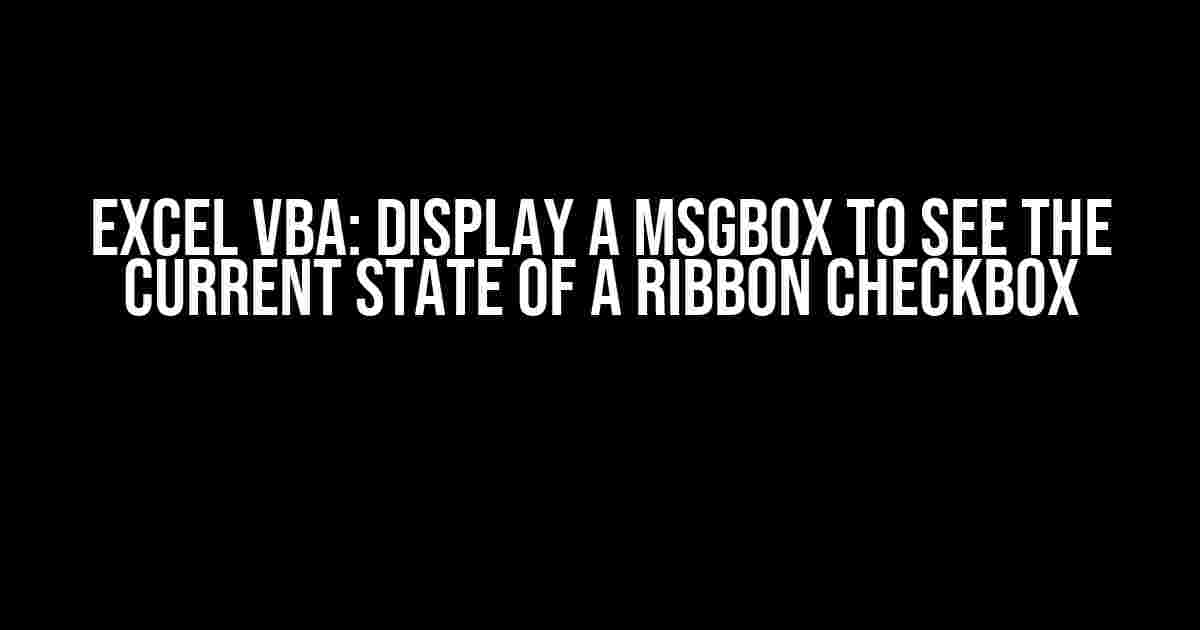Are you tired of scratching your head, wondering if that ribbon checkbox is checked or not? Well, wonder no more! In this article, we’ll show you how to use Excel VBA to display a MsgBox that reveals the current state of a ribbon checkbox.
Why do I need to do this?
You might be thinking, “Why do I need to display a MsgBox to check the state of a ribbon checkbox?” Well, my friend, there are several reasons:
- You want to debug your code and ensure that the checkbox is behaving as expected.
- You need to track the state of the checkbox for auditing or logging purposes.
- You want to provide visual feedback to the user about the current state of the checkbox.
Prerequisites
Before we dive into the code, make sure you have:
- Microsoft Excel 2007 or later installed on your machine.
- A basic understanding of Excel VBA (Visual Basic for Applications).
- A ribbon checkbox created in your Excel workbook.
The Code
Now, let’s get to the good stuff! Create a new module in your Excel VBA editor and paste the following code:
Sub DisplayCheckBoxState()
Dim ribbonCheckBox As IRibbonControl
Set ribbonCheckBox = Application.CommandBars("Ribbon").Controls("CheckBox1")
If ribbonCheckBox.Checked Then
MsgBox "The checkbox is checked."
Else
MsgBox "The checkbox is not checked."
End If
End Sub
Breaking it down
Let’s walk through the code step-by-step:
Dim ribbonCheckBox As IRibbonControl: We declare a variableribbonCheckBoxas anIRibbonControl, which represents the ribbon checkbox.Set ribbonCheckBox = Application.CommandBars("Ribbon").Controls("CheckBox1"): We set theribbonCheckBoxvariable to the ribbon checkbox control named “CheckBox1” using theApplication.CommandBarsobject.If ribbonCheckBox.Checked Then ... Else ... End If: We use anIf...Then...Elsestatement to check the state of the checkbox. If it’s checked, we display a MsgBox saying “The checkbox is checked.” If not, we display a MsgBox saying “The checkbox is not checked.”
Running the Code
Now that we have the code, let’s run it! Follow these steps:
- Open your Excel workbook.
- Press
Alt + F11to open the Visual Basic Editor. - In the Visual Basic Editor, click
Run>Run Sub/User Formto execute theDisplayCheckBoxStatesubroutine. - A MsgBox will appear, indicating the current state of the ribbon checkbox.
Troubleshooting
If you encounter any issues, check the following:
- Make sure you have the correct ribbon checkbox name in the code (e.g., “CheckBox1”).
- Verify that the ribbon checkbox is properly created and accessible in your Excel workbook.
- Check for any syntax errors in the code.
Conclusion
In this article, we’ve shown you how to use Excel VBA to display a MsgBox that reveals the current state of a ribbon checkbox. With this knowledge, you can now create more interactive and user-friendly interfaces in your Excel workbooks.
Bonus: Displaying the checkbox state in a cell
What if you want to display the checkbox state in a cell instead of a MsgBox? No problem! Simply replace the MsgBox statements with the following code:
Sub DisplayCheckBoxStateInCell()
Dim ribbonCheckBox As IRibbonControl
Set ribbonCheckBox = Application.CommandBars("Ribbon").Controls("CheckBox1")
If ribbonCheckBox.Checked Then
Range("A1").Value = "The checkbox is checked."
Else
Range("A1").Value = "The checkbox is not checked."
End If
End Sub
In this modified code, we use the Range object to write the checkbox state to cell A1 (or any other cell of your choice). Run the code, and the checkbox state will be displayed in the cell!
| CheckBox State | Cell Value |
|---|---|
| Checked | The checkbox is checked. |
| Unchecked | The checkbox is not checked. |
Now you have two ways to display the checkbox state: using a MsgBox or writing to a cell. Choose the method that suits your needs!
Remember, the possibilities are endless when it comes to Excel VBA. Keep exploring, and happy coding!
Frequently Asked Question
Get ready to uncover the secrets of Excel VBA and ribbon checkboxes! We’ve got the answers to your most pressing questions about displaying a MsgBox to see the current state of a ribbon checkbox.
How do I display a MsgBox to see the current state of a ribbon checkbox in Excel VBA?
You can use the following code to display a MsgBox showing the current state of a ribbon checkbox: `MsgBox Application.CommandBars(“Ribbon”).Controls(“YourCheckBoxName”).State`. Replace “YourCheckBoxName” with the actual name of your checkbox.
What if I have multiple ribbon checkboxes and I want to display the state of all of them?
No problem! You can use a loop to iterate through all the checkboxes and display their states. Here’s an example: `For Each ctrl In Application.CommandBars(“Ribbon”).Controls: If ctrl.Type = msoControlCheckBox Then MsgBox ctrl.Id & “: ” & ctrl.State: Next ctrl`. This code will display a MsgBox for each checkbox, showing its ID and current state.
How do I get the name of my ribbon checkbox in Excel VBA?
You can get the name of your ribbon checkbox by using the `Application.CommandBars(“Ribbon”).Controls` collection. You can loop through the collection and display the `ctrl.Id` or `ctrl.Caption` properties to find the name of your checkbox. Alternatively, you can use the Visual Basic Editor to look at the properties of your checkbox and find its name.
Can I use this code in a worksheet module or does it need to be in a separate module?
You can use this code in either a worksheet module or a separate module. However, if you want to use the code in a worksheet module, make sure to qualify the `Application` object with the worksheet object, like this: `ThisWorkbook.Application.CommandBars(“Ribbon”).Controls(“YourCheckBoxName”).State`. If you use a separate module, you can use the code as-is.
What if I want to display the state of the checkbox in a cell instead of a MsgBox?
Easy peasy! Instead of using `MsgBox`, you can use the `Range` object to display the state of the checkbox in a cell. For example: `Range(“A1”).Value = Application.CommandBars(“Ribbon”).Controls(“YourCheckBoxName”).State`. Just replace “A1” with the cell where you want to display the state.
